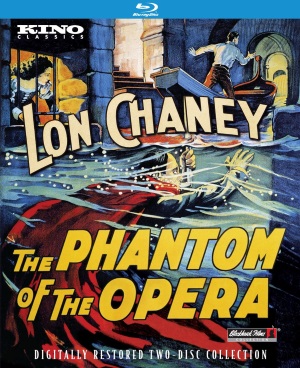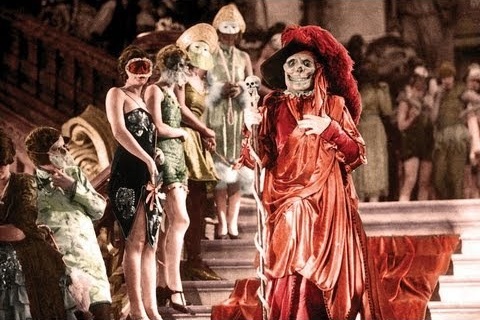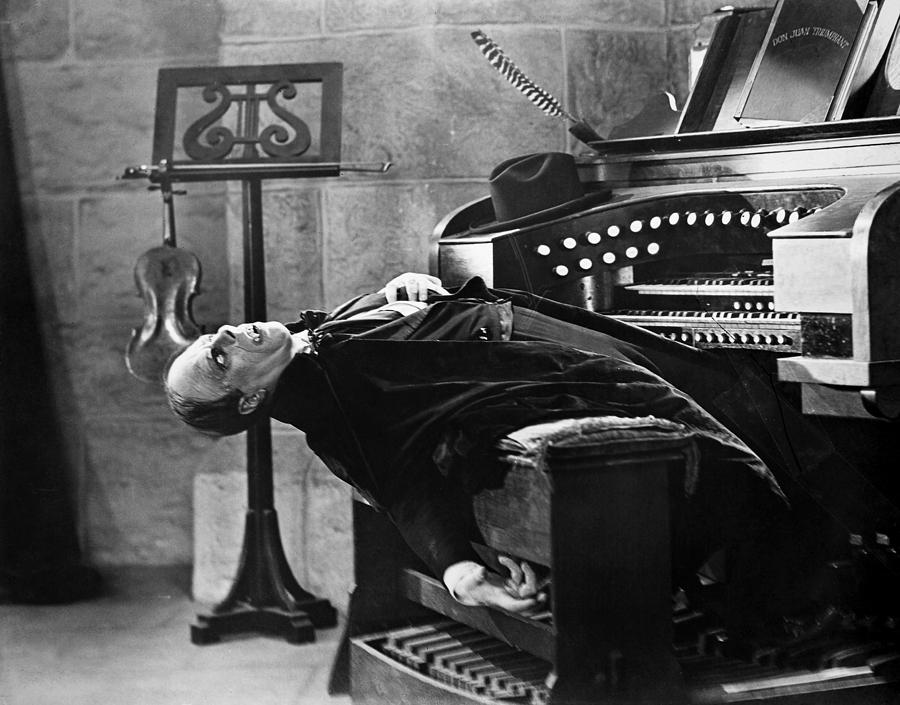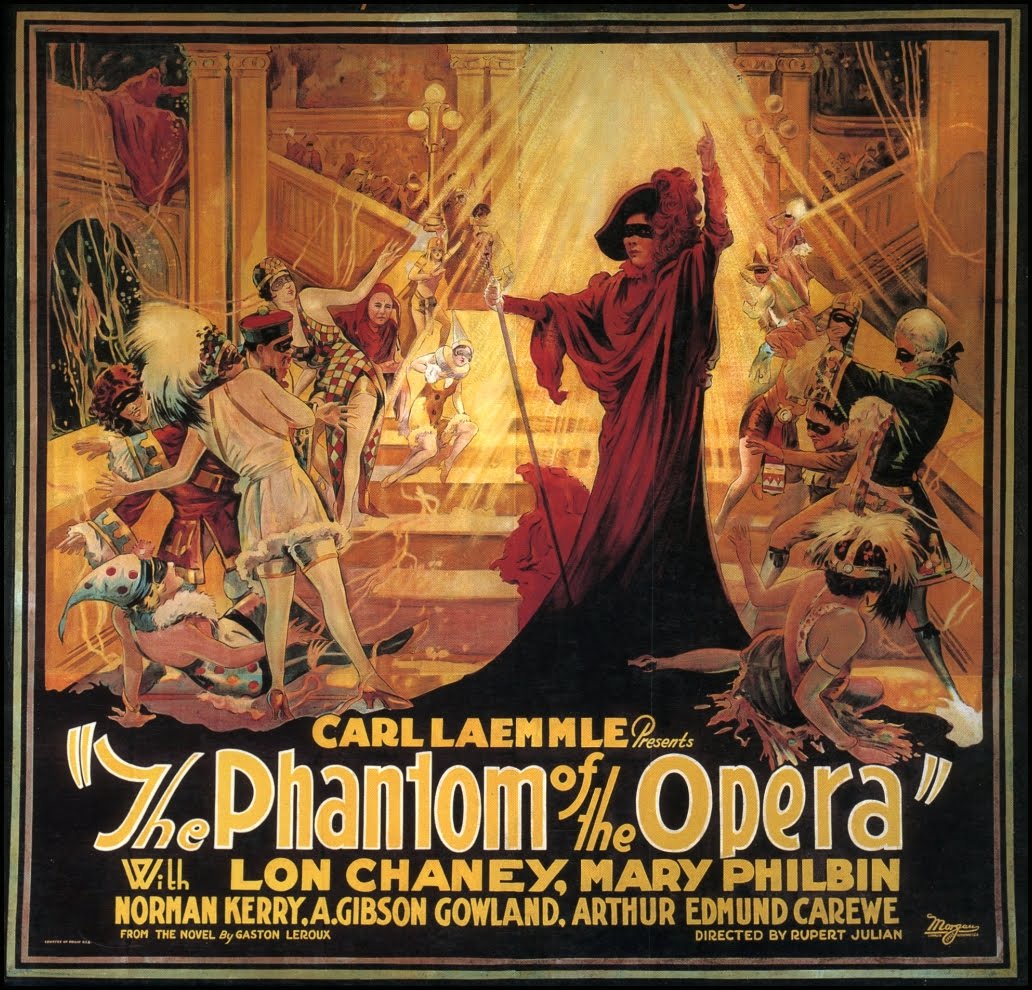 Lon Chaney became a star for The Hunchback of Notre Dame (1923) but it was the 1925 The Phantom of the Opera (Kino Classics, Blu-ray, DVD) that confirmed his stardom and his talent.
Lon Chaney became a star for The Hunchback of Notre Dame (1923) but it was the 1925 The Phantom of the Opera (Kino Classics, Blu-ray, DVD) that confirmed his stardom and his talent.
The first version of many versions of the Gaston Leroux novel is still considered the definitive, thanks to Chaney’s committed performance (right down to enduring painful make-up that he himself designed to give him a death’s head look and a horrifying rictus grin) and magnificent sets for the grand Paris Opera and the underground labyrinth of tunnels and canals and secret rooms. This lavishly executed production threatens to slip into hoary melodrama with a magnificent backdrop but for Chaney’s performance.
Chaney, however, creates both a monstrous and a tortured villain, part shunned mastermind, part proto-Frankenstein monster smitten with a young beauty His backstory is left blank, which allows the viewers to fill in their own from his aristocratic bearing, his maniacal pounding on a pipe organ in his underground dungeon lair and his obsessive pursuit of the comely young understudy Christine (Mary Philbin), whose stardom he engineers via secret coaching and threats to the opera company owners. Chaney is both tender and terrible, wooing Christine from behind a mask, a mystery lover who dedicates his heart and soul to her success, then turns vindictive when she spurns him.
This was a troubled production, full reshoots and drastic re-edits that dragged on for two years and a few directors, finally released in 1925 with original director Rupert Julian’s name listed as director (reshoots were by Edward Sedgewick and others), and edited down again for a 1929 reissue with a synchronized soundtrack. And yet moments of beauty and terror survive the creative struggles and production upheavals: The grand chandelier crashing down to the floor of the opera house, The Phantom taking Christine through the underground canals like a fairy tale gondola poled by a demonic boatman through a literal underworld; the furious Phantom perched like a gargoyle on the roof of the opera house in a terrible storm listening to the object of his obsession betray her promise to him. Most dazzling and haunting is the costume ball sequence. A number of scenes were shot in the primitive and unstable two-color Technicolor process but this is the only color scene to survive and it is astounding: the revelry and merriment stops dead when The Phantom, costumed up as the Red Death complete with a grinning skull mask, marches down the staircase and through the frozen crowd.

Lon Chaney as the Red Death in the restored color sequence
Kino’s two-disc Blu-ray features the same editions previously released on a single Blu-ray by Image: three versions of the film with four different scores. I can’t see a visual difference between the editions but the Kino edition looks superb and, spread across two discs, allows for less compression and a higher bit-rate. The best surviving materials are from the 1929 reissue, which is mastered from archival 35mm elements with color tints and presented in two versions: at standard sound speed of 24 frames per second, or fps, with a new score by the Alloy Orchestra and an archival 1974 theater organ score by Gaylord Carter, and at 20 fps with a superb orchestral score composed by Gabriel Thibaudeau and performed by I Musici de Montreal. The 24 fps master is visually stronger but the 20 fps version is looks more accurate and appropriate in terms of movement on the screen. Both feature the color sequence and appropriate tints through the B&W scenes. The original (and longer) 1925 cut is taken from a surviving 8mm reduction print (without the color sequence) and presented with a piano score by Dr. Frederick Hodges. The drop in image quality is significant, due to the source (a worn and fuzzy print, probably a few generations removed from the negative), which is unrestored and presented in 1080i.
The commentary by film historian Jon C. Mirsalis, also carried over from the Image release, is on the 1929 reissue at 24fps, and accessed through the audio options available on that version. There’s also an interview with composer Gabriel Thibaudeau, the original screenplay, and the trailer.
New to this edition is nearly an hour of excerpts from the 1930 sound reissue with a synchronized soundtrack and some new dialogue scenes added. Only nine minutes of the sound version exists on film but the entire audio survives and the disc presents a mix of audio only, silent footage synchronized to the discs, and the surviving sound film footage.
Also new are two archival shorts showing Paris in 1925: Paris From a Motor and A Trip on the Seine.
Calendar of upcoming releases on Blu-ray, DVD, Digital, and VOD


